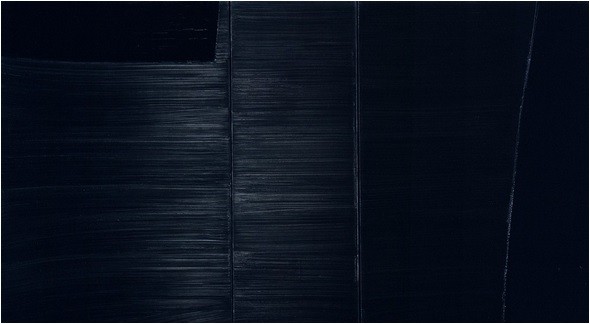Artists Who Use Black and White Paint
Since ancient times, black has been closely linked to melancholy, cynicism and madness. While it may take on sad and dark connotations in our culture, the history of this color is more nuanced than just these ideas. In the writings of famous myths, after the experience of night comes the dazzling clarity of truth. Artists' fascination with black is a common theme throughout the history of art, as many artists have obsessed over it.
In 2016, Anish Kapoor gained the exclusive rights to Vantablack, the darkest shade, to the great anger of artists and critics who were in uproar by his monopoly over this color. Because this controversy over the color black still rages today, Artsper is revisiting these artists who are fascinated by the history of this color and all its nuances.
1. PIERRE SOULAGES
It is impossible not to think of the color black without thinking of Pierre Soulages. This great master is known as one of the major figures in abstraction and is the greatest living French artist. Soulages works use black in all its varying shades. For him, black is never completely just black.
Its intensity changes according to the dimensions of the support, its shape and its texture. One of his most recognized concepts is the Outrenoir, which he started in 1979, when he began to cover the entire surface of his canvases with a thick layer of black paint. Paradoxically, it is light that is at play in Soulages' black paintings.
The light reflected on the surface of these paintings, and the reflections from their grooves, ridges and smooth textures. The optical mixture between the brightness of the reflections and the black makes a purely black palette appear varied. Consequently, each painting is a unique experience and cannot be appreciated fully in photos. "Here, it is the light that emanates from the black itself, and which resonates, becoming animated under the eyes of the one who is looking, who can see forms appearing and disappearing.".
Discover 10 Things To Know About Pierre Soulages

2. MARK ROTHKO
Black is also the color and tone that Mark Rothko (1903-1970) chose for his famous Black paintings. This series was his last before his tragic suicide, thus creating a direct link between the color black and his mental state of paranoid depression. However, for Rothko, black is a positive color.
Durant les années soixante, une riche collectionneuse s'était rendue dans son atelier où l'artiste, avait mis son œuvre en exposition. Elle n'y trouva que des tableaux sombres aux aplats noircis. Décontenancée, elle fit la remarque suivante: « Pour être honnête, je cherchais quelque chose de rouge, de rose, un tableau plus joyeux ». Sur quoi Rotkho rétorqua: « Rose, rouge, jaune, orange ? Ne sont-elles pas les couleurs de l'enfer ? ».
During the sixties, a rich collector visited his studio where the artist had been exhibiting his work. There she found only dark paintings with flat blackened surfaces. Disconcerted she made the following remark: "To be honest, I was looking for something red, or pink, something a bit more joyful". To which Rothko replied: "Pink, red, yellow, orange? Are they not the colors of hell?".
Discover 10 Things To Know About Mark Rothko

3. JACKSON POLLOCK
Pollock is also famous for his series of Black paintings. We can see dense interlacing of black lines sprayed violently across the surface of the canvas. Nevertheless, the idea that all of this is spontaneous is not true, as Pollock carefully considered each composition and the location of the lines before dribbling and pouring in his famous style.
Plusieurs institutions, dont le Dallas Museum of Art, s'accordent à dire que cette série est ce que Pollock a produit de plus construit. Totalement méconnus en comparaison à ses drippings colorés, les tableaux noirs de Pollock constituent une transition de taille au sein de sa carrière.
Several institutions, including The Dallas Museum of Art, agree that this is the most important series that Pollock created. Completely unknown compared to his colorful pieces, Pollock's black paintings mark a major transition in his life.
Discover 10 Things To Know About Jackson Pollock

4. RICHARD SERRA
For Richard Serra, black is a color that always changes a space. It dominates both artificial and natural light, which holds its own space and always relates to a larger space whose composition it modifies.
According to the artist, "black is the easiest way to mark a white area, whether charcoal or graphite is used." In a more abstract way, it is also the simplest way to avoid the association of ideas.
Serra explains that "it is possible to cover a surface with black without fear of metaphorical misinterpretations."

5. HENRI MATISSE
Henri Matisse, the incontestable master of color, through using black found a method of expression that is consistent with his constant search for simplicity and purity, characteristic of his work.
Black and its multiple nuances offered him the necessary range in order to depict a face, a nude, dead leaves.
Famous for being a painter and a sculptor, this great master is lesser known as a draughtsman, even though he engraved nearly 900 prints and illustrated more than 90 books. The whole universe of Henri Matisse appears to us in black on white, white on black.
Discover 10 Things To Know About Henri Matisse

In conclusion, black has not always been considered as a color throughout the history of art, but today it is impossible to not consider it as such due to the artists who have charged it with symbolism. Of course, these five artists are not the only ones to use black in their works, they are accompanied by many other talents whose works are present on Artsper.
You may also like
Artists Who Use Black and White Paint
Source: https://blog.artsper.com/en/get-inspired/5-artists-for-whom-black-is-a-color/